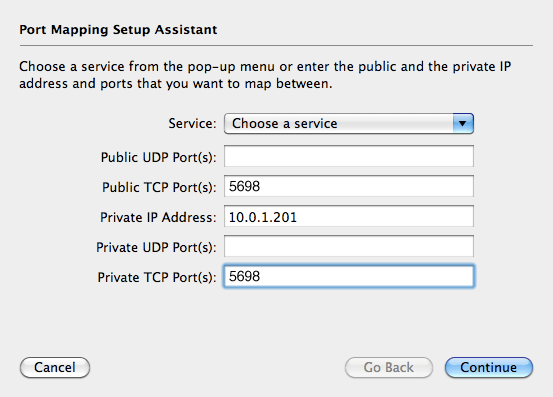
- #MAC AIRPORT UTILITY PUBLIC UDP PORTS UPDATE#
- #MAC AIRPORT UTILITY PUBLIC UDP PORTS PLUS#
- #MAC AIRPORT UTILITY PUBLIC UDP PORTS MAC#
Reach over 20,000 buyers for your items for only 5, if you come in and prepay for a personal ad, it’s only 4 for your 20-word. The private port number is the port we looked up at the beginning: 51234. Trader’s brings 1000s of buyers and sellers together every week. UDP and TCP are two different types of networking protocol if in doubt, enter the same information for both.īy default, AirPort Utility fills in the IP address of the machine you’re using as the address of the computer to which you want to forward traffic, but you can enter the IP of any machine on your network. To make things simple, I’m going to use the same port number for the public and private connections, but you could use a different public-facing number if you need to. This is important to prevent hackers from getting into your network or using the item you are port fowarding. This is so port scanners can not detect what service might be running on your IP Address.

Public UDP/TCP Ports) For security reasons, you should pick a number above 40000. The public ports are the ports that my friends will enter when they want to access my server. 3) Next assign the port for connecting from the outside world (e.g. appears to be is that the firewall entry for the tunnel public interface is limited to either 'Allow Specific TCP and UDP ports' or 'All services and ports' - so to open up ICMP, you have to allow all TCP and UDP as well. The following sheet might look daunting, but it’s fairly straightforward.įor description, enter the name of the service-in this case, MapTool. This is was last tested with AirPort firmware 7.6.3 and AirPort Utility 6.3.1.
#MAC AIRPORT UTILITY PUBLIC UDP PORTS PLUS#
To create a new forwarding rule, click the Plus (+) button. Launching AirPort Utility, I select my router and click “Edit.” The port forwarding section is listed under the Network tab and labeled Port Settings. Under Advanced: Port Mapping, I added a new entry with the same values for each combination of fields: Public/Private UDP/TCP Port: 9000 Private IP Address: 10.0.0.5.
#MAC AIRPORT UTILITY PUBLIC UDP PORTS MAC#
I know from its server configuration screen that it expects incoming traffic on port 51234. I've created a DHCP Reservation based on wireless MAC address for the laptop, 10.0.0.5. For this example, I’m using an open-source app called MapTool, which lets me play online games with my friends.
#MAC AIRPORT UTILITY PUBLIC UDP PORTS UPDATE#
Finally, click Update and wait for the changes to be applied. Change ‘Private IP Address’ to your LAN IP address typically 10.0.1.1 and then type 548 into both the ‘Private UDP Ports’ and ‘Private TCP Ports’ boxes. Public TCP Port(s): 6112 Public UDP Port(s. Ignore the warning, then type 8888 in both the ‘Public UDP Ports’ and ‘Public TCP Ports’ boxes. Make sure it is selected and hit continue. (MAC not Mac - it is a unique identifier for each network card). First things first: Find the port number that you need to forward to. You can use Airport Utility (it should be found in the Applications/Utilities folder) to setup a static IP address which may prove easier to do than manually configuring it in OS X.


 0 kommentar(er)
0 kommentar(er)
